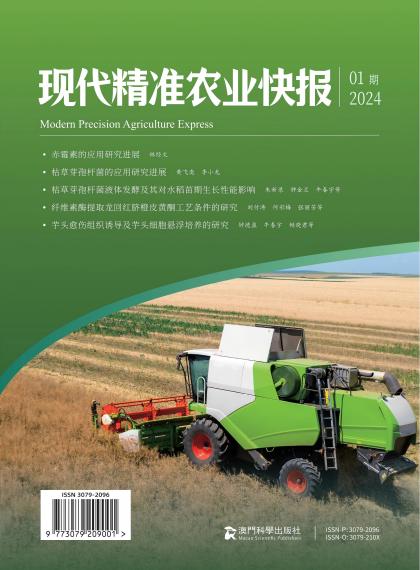摘 要:目的:筛选出适宜进行芋头愈伤组织诱导的外植体,探究适宜芋头愈伤组织继代培养及细胞悬浮培养的部分条件。方法:以芋头顶芽、腋芽、新生的幼嫩叶片、块茎和须根作为外植体材料,开展芋头愈伤组织诱导、不同条件下继代培养,不定芽、不定根增殖研究及不同条件下芋头细胞悬浮培养研究。结果:芋头愈伤组织诱导的最佳外植体为块茎,腋芽适宜进行不定芽、不定根的增殖研究;其继代培养宜在光照条件、NAA 0.5 mg/L + 6-BA 1 mg/L激素组合下进行;6-BA 1 mg/L + NAA 0.5 mg/L激素组合中不定芽增殖系数最高,达到4.67,6-BA 0.5 mg/L + NAA 1 mg/L激素组合中不定根增殖系数最大,达到5.33;芋头细胞悬浮培养的最佳激素配比为6-BA 2 mg/L + 2,4-D 1 mg/L,最佳蔗糖浓度为40 g/L;建立悬浮细胞动态生长曲线,发现芋头细胞悬浮培养最佳继代周期为16d;最后,进行到第五代继代培养时细胞大部分呈现球形,细胞系趋于稳定。
关键词:芋头;愈伤组织;细胞培养
Abstract: Objective: To screen suitable explants for inducing taro callus tissue and explore some conditions suitable for taro callus subculture and cell suspension culture. Method: Using taro apical buds, axillary buds, newly formed tender leaves, tubers, and fibrous roots as explant materials, taro callus induction, subculture under different conditions, proliferation of adventitious buds and roots, and suspension culture of taro cells under different conditions were conducted. Result: The optimal explant for inducing callus in taro is tuber, and axillary buds are suitable for studying the proliferation of adventitious buds and roots; Its subculture should be carried out under light conditions and a combination of NAA 0.5 mg/L + 6-BA 1 mg/L hormones; The combination of 6-BA 1 mg/L + NAA 0.5 mg/L had the highest adventitious bud proliferation coefficient, reaching 4.67, while the combination of 6-BA 0.5 mg/L+NAA 1 mg/L had the highest adventitious root proliferation coefficient, reaching 5.33; The optimal hormone ratio for suspension culture of taro cells is 6-BA 2 mg/L + 2,4-D 1 mg/L, and the optimal sucrose concentration is 40 g/L; Establishing a dynamic growth curve of suspension cells, it was found that the optimal subculture cycle for taro cell suspension culture is 16 days; Finally, by the fifth generation of subculture, most of the cells appeared spherical and the cell line tended to stabilize.
Keywords: Taro; Callus tissue; Cell culture
--
